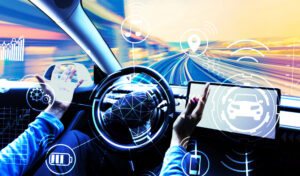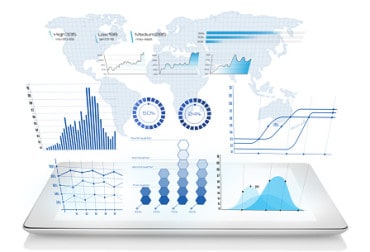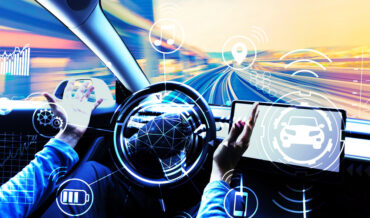
By leveraging the insights gained from data analysis and the capabilities of emerging technologies, the auto industry can usher in an era where accidents are not just reduced but ultimately prevented, ensuring safer journeys for all.
When imagining the car of the future, it’s hard to overestimate the critical role that safety features will play in its development. The vehicles of the future will not just be luxurious and intelligent but also equipped with next-gen safety features that reduce the risk of accidents.
The renewed focus on safety is already evident. We’ve recently witnessed substantial improvements in advanced driver assistance systems (ADAS), which function as a form of vehicle co-pilot to help drivers navigate the road. ADAS features include automatic braking, lane departure warning, and adaptive cruise control – features that either take over for the driver or alert the driver to change behavior. That’s why ADAS is also an incremental step on the road to complete vehicle autonomy.
Research suggests that ADAS systems could prevent up to 60 percent of all traffic-related injuries. However, that efficacy depends on providing the systems with high-quality data captured from a diverse assortment of sensors. Vehicle manufacturers thus need to collect and collate real-time data and then integrate the data into ADAS and other autonomous counterparts. That’s the future of safety: the collection, analysis, and implementation of fine-scale data to prevent accidents.
Capturing essential data
As it stands, vehicle safety systems are overly reliant on visual perception data at the expense of other senses. However, ADAS systems – and their subsequent counterparts on the road to autonomy – don’t need to just see like a driver but also feel like one. Simply put, vehicles require more sensory input to drive as a person does, and they need more data to navigate the road more safely.
Consequently, advancements in data collection and analysis are poised to significantly enhance vehicle safety and accident prevention. Next-generation vehicle sensors will surpass traditional technologies like cameras and radar, capturing intricate details about both the vehicle and its surrounding environment. This evolution is vital as it enables a more holistic understanding of the road, with safety improvements reliant on the vehicle’s ability to “feel” its surroundings.
Tactile sensors play a pivotal role in this regard, allowing vehicles to perceive and interact with the external world as human drivers do. These sensors not only discern potential road hazards and weather conditions, but they also gauge interactions between the vehicle and the pavement, including tire grip and friction. By amalgamating data from diverse sources, tactile sensors provide real-time feedback to the vehicle’s onboard systems, fostering a comprehensive understanding of the driving environment through continuous monitoring.
Moreover, advancements in Inertial Measurement Units (IMUs) further enhance the capabilities of ADAS. These sophisticated sensor systems, comprising accelerometers and gyroscopes, furnish essential data about the vehicle’s motion characteristics, including acceleration, orientation, and angular velocity. IMUs contribute to ADAS features like lane-keeping assist and adaptive cruise control by providing real-time data on the vehicle’s motion dynamics. This information allows the system to make precise adjustments to steering, braking, and acceleration.
See also: What Autonomous Vehicles Can Learn from IoT about Real-Time Design
Enhancing ADAS
The advancement of ADAS relies heavily on the accumulation of more extensive and higher-quality data. Virtual vehicle sensors play a pivotal role in this evolution, augmenting the effectiveness of ADAS by furnishing precise and dependable data inputs, often where traditional sources are insufficient.
For instance, tactile sensors can supplement traditional vision-based sensors by offering feedback that corroborates visual information, thereby increasing the system’s overall accuracy and reliability. Moreover, tactile sensors provide crucial insights into variables such as road friction coefficients, vehicle weight, and tire conditions. This additional data enables more precise predictions, especially in scenarios where visual sensors encounter challenges, like during inclement weather or in poorly lit conditions.
Tactile sensors excel in capturing physical interactions and feedback, such as pressure, vibration, and contact, which are crucial for understanding the dynamics of the vehicle’s environment. By supplementing traditional vision-based sensors, tactile sensors offer a complementary perspective that enhances ADAS’s overall perception capabilities.
Another improvement in ADAS sensory perception stems from the advent of LIDAR, which uses laser pulses to create high-resolution 3D maps of the vehicle’s surroundings. LIDAR is highly effective in detecting objects, measuring distances, and identifying potential collision hazards. As a result, it also plays a critical role in autonomous driving systems and ADAS by providing precise data for navigation, object recognition, and collision avoidance.
Reducing human error
As the automotive industry steers toward the future, there’s a growing emphasis on accident prevention and minimizing human error. While autonomous vehicles are currently not flawless, the provision of extensive data can significantly enhance their safety.
Over 90 percent of accidents are caused, at least in part, by human error. By leveraging the wealth of data available, we can furnish vehicles with the capabilities to navigate intricate driving scenarios with precision and foresight. Continuous advancements in vehicle safety technology, coupled with robust data-driven systems like the emergence of V2X connectivity combined with cloud data storage, hold immense promise in diminishing the impact of human error on road safety.
As we strive towards a future of safer roads and reduced accident rates, it is imperative that we continue to invest in research and development efforts aimed at enhancing vehicle safety through data-driven innovation. By leveraging the insights gained from data analysis and the capabilities of emerging technologies, we can usher in an era where accidents are not just reduced but ultimately prevented, ensuring safer journeys for all.




























